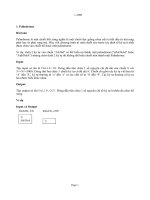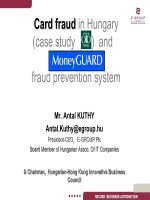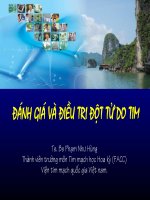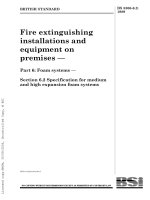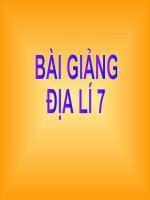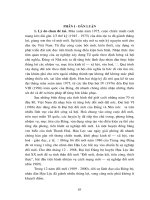Bsi bs au 217 2 1989 (2000)
Bạn đang xem bản rút gọn của tài liệu. Xem và tải ngay bản đầy đủ của tài liệu tại đây (407.39 KB, 15 trang )
BRITISH STANDARD AUTOMOBILE SERIES
Maximum road speed
limiters for motor
vehicles —
Part 2: Specification for system and
component requirements
UD C 62 9. 1 1 - 585. 7
Reprodu ced by I H S u n d er l i cen se wi th BSI - U n con trol l ed Copy
BS AU 21 7-2:
1 989
BS AU 21 7-2:1 989
Committees responsible for this
British Standard
The preparation of this British Standard was entrusted by the Automobile
Standards Policy Committee (AUE/- ) to Technical Committee AUE/1 3, upon
which the following bodies were represented:
British Railways Board
Bus and Coach Council
Department of Transport (Highways)
Department of Transport (TRRL)
Freight Transport Association
Health and Safety Executive
Institute of Road Transport Engineers (Incorporated)
London Regional Transport
Ministry of Defence
Road Haulage Association Ltd.
Society of Motor Manufacturers and Traders Limited
This British Standard, having
been prepared under the
direction of the Automobile
Standards Policy Committee,
was published under the
authority of the Board of BSI
and comes into effect on
Amendments issued since publication
28 February 1 990
© BSI 02- 2000
The following BSI references
relate to the work on this
standard:
Committee reference AUE/1 3
Draft for comment 87/75795 DC
ISBN 0 5 80 1 7249 X
Reprodu ced by I H S u n d er l i cen se wi th BSI - U n con trol l ed Copy
Amd. No.
Date of issue
Comments
BS AU 21 7-2:1 989
Contents
Page
Committees responsible
Foreword
Inside front cover
ii
1
Scope
1
2
Definitions
1
3
Durability and environmental performance
1
4
Marking
2
Appendix A System durability test
3
Appendix B Time and temperature stability test
3
Appendix C Transient voltage test severity levels
4
Appendix D Sinusoidal vibration test
4
Appendix E Additional tests
5
Figure 1 — Test layout
3
Figure 2 — Driving rain test: test cabinet nozzle
arrangement (6 nozzles: 4 angled, 2 horizontal)
Table 1 — Maximum supply line interference levels
2
Table 2 — Transient voltage test severity levels
4
Publications referred to
© BSI 02- 2000
Reprodu ced by I H S u n d er l i cen se wi th BSI - U n con trol l ed Copy
7
Inside back cover
i
BS AU 21 7-2:1 989
Foreword
This Part of BS AU 21 7 has been prepared under the direction of the Automobile
Standards Policy Committee.
Part 1 of this standard deals with the requirements relating to the performance
of the assembled system making up the speed limiter device when installed in a
vehicle.
A British Standard does not purport to include all the necessary provisions of a
contract. Users of British Standards are responsible for their correct application.
Compliance with a British Standard does not of itself confer immunity
from legal obligations.
Summary of pages
This document comprises a front cover, an inside front cover, pages i and ii,
pages 1 to 8, an inside back cover and a back cover.
This standard has been updated (see copyright date) and may have had
amendments incorporated. This will be indicated in the amendment table on the
inside front cover.
ii
Reprodu ced by I H S u n d er l i cen se wi th BSI - U n con trol l ed Copy
© BSI 02- 2000
BS AU 21 7-2:1 989
3.2 Time and temperature stability
1 Scope
This Part of BS AU 21 7 specifies requirements for
The system, in a condition equivalent to new, shall
the performance of systems and components
be tested in accordance with Appendix B. During
designed to form part of a speed limiter intended to
the procedures in B.1 to B.7 and B.9 the sensed
limit the maximum road speed of motor vehicles by
speed shall not differ from the set speed by more
control of engine power.
than 2 mile/h.
Appendix A gives a system durability test,
3.3 Electrical power supply
Appendix B, a time and temperature stability test,
3.3.1
Appendix C shows transient voltage test severity
levels, Appendix D a sinusoidal vibration test and
Appendix E gives additional tests which systems
manufacturers may wish to include in their own
3.3.1 .1 The system shall function normally when
connected to a power supply in the range 20 V
to 30 V (1 0 V to 1 6 V) d. c.
3.3.1 .2 The system shall be tested at 1 0 V
specifications.
NOTE 1
Steady state voltage
Not all the requirements given will necessarily apply
and 40 V (5 V and 20 V) d. c. , for a period of 1 0 min
to every speed limiter system. For example, some are of a
at each, with a sweep between these maximum and
mechanical nature and therefore electrical characteristics will
minimum values. The change from nominal voltage
not be applicable.
NOTE 2
The titles of the publications referred to in this
standard are listed on the inside back cover.
NOTE 3
All voltages are quoted for nominal 24 V systems and,
in brackets, for 1 2 V systems i. e. 24(1 2) .
to each extreme and from each extreme to nominal
voltage shall take place over a time interval
of 1 0 ms.
The system may fail to function but it shall not be
permanently damaged and shall return to normal
2 Definitions
function when the power supply is returned to
For the purposes of this Part of BS AU 21 7 the
normal.
definitions given in BS AU 21 7- 1 apply, together
3.3.2
with the following.
not be affected by regular or irregular variations in
2.1
voltage about the prevailing supply level (excluding
permanent damage
transients) not exceeding 3 V (2 V) peak to peak in
damage sustained by a component or system which
Rip p le.
Normal operation of the system shall
the range 1 0 Hz to 1 0 kHz.
The system may fail to
renders it inoperative. For the purpose of this
3.3.3
definition the rupture of a fuse or the operation of
function but it shall not be permanently damaged
other user serviceable circuit protection devices is
when subj ected to a reversal of polarity of the supply
not taken to be permanent damage
referred to in 3.3.1 .1 for 1 min and shall return to
Rev erse p olarity.
normal function when the power supply is returned
2.2
to normal.
normal function
functioning in accordance with the requirements of
Part 1 of this standard
3.3.4
Transients .
Tests for immunity to transients
shall be conducted in accordance with ISO 7637- 1
for 1 2 V systems and ISO 7637- 2 for 24 V systems.
2.3
Transient voltage test severity levels are given in
failure to function
Appendix C.
functioning outside the requirements of Part 1 of
3.3.5
this standard but not suffering any permanent
damage
Input/output protection
3.3.5.1 Each output in turn shall withstand
connection to earth for 1 min duration, without
2.4
permanent damage, with the system operating and
nominal voltage
shall return to normal function when the connection
a voltage of 28(1 4)
±1
V d. c
is removed.
3.3.5.2 Each input in turn shall withstand a
3 Durability and environmental
performance
3.1 System durability
connection to earth and to supply for 1 min, without
permanent damage, with the system operating and
shall return to normal function when the connection
is removed.
The system, in a condition equivalent to new, shall
be tested in accordance with Appendix A and, after
completion of the test, shall comply with the
manufacturer’s specification.
© BSI 02- 2000
Reprodu ced by I H S u n d er l i cen se wi th BSI - U n con trol l ed Copy
1
BS AU 21 7-2:1 989
3.3.6
Electromagnetic compatibility
3.3.6.1
Sup p ly line interference.
When tested in
accordance with BS 3G 1 00- 4. 2: 1 980 (civil
3.4.2 Low temperature storage test in accordance
with BS 201 1 - 2. 1 A at a temperature of:
a) – 25 ° C for cab mounted components;
applications), the system shall operate correctly
b) – 40 ° C for engine and chassis mounted
with 3 V r. m. s. interference, at any frequency in the
components.
range 1 Mhz to 1 50 Mhz, superimposed on either
battery supply line with respect to a reference
ground plane.
3.3.6.2
Electro m agnetic em issions.
Using the test
procedure described in paragraph 4 of
DIN 57879- 3: 1 981 and with the values of
electromagnetic emissions measured on the output
port of a 50
7 line impedance stabilizing network
The period for this test shall be 96 h after the
component has reached the required temperature.
Return the component to 1 8 ± 2 °C at a rate not
exceeding 1 °C/min and test.
3.4.3 Using the component tested under 3.4.2 , carry
out a high temperature storage test in accordance
with BS 201 1 - 2. 1 B at temperature of:
using a CISPR quasi- peak measuring receiver
a) + 80 ° C for cab mounted components;
(both of which shall meet the requirements of
b) + 1 40 ° C for engine mounted components;
BS 727), the system under test shall not cause
interference in the supply line exceeding the values
c) + 1 00 ° C for chassis mounted components.
shown in Table 1 , or their equivalent if other
The period for this test shall be 96 h after the
equipment is used.
component has reached the required temperature.
Table 1 — Maximum supply line
interference levels
Frequency band
Measured level relative to 1
microvolt in 5 0
7 (+ dB)
Return the component to 1 8 ± 2 °C at a rate not
exceeding 1 °C/min and test.
3.4.4 Using the component tested under 3.4.3 carry
out a humidity storage test in accordance with
BS 201 1 - 2. 1 Z/AD and test after the drying period.
MHz
3.4.5 Using the component tested under 3.4.4 carry
0. 1 5 to 0. 29
70 level
0. 30 to 4. 90
60 level
5. 00 to 29
50 level
3.4.6 Submit engine and chassis mounted
30 to 1 08
slope 50 to 30
components tested under 3.4.5 to a salt mist test in
3.3.6.3
RF field sus cep tib ility.
out a sinusoidal vibration test as given in
Appendix D, and after, test for normal function.
accordance with BS 201 1 - 2. 1 Ka, for a period of 96 h
When tested in
and after test for normal operation.
accordance with the procedure described in DEF
NOTE
STAN 59- 41 , Part 3, Issue 2: 1 986 (DRSO2 radiated
manufacturers are described in Appendix E.
susceptibility) the system shall function normally
Additional tests which may also be considered by
when subj ected to an R F field of 1 40 dB
4 Marking
above 1
Each control unit and actuator shall be marked with
4V/m (1 0 V/m)
over a frequency range
of 1 Mhz to 220 Mhz.
the following:
3.4 Environmental protection
a) the number of this British Standard,
3.4.1 Components of the system shall be subj ected to
i. e. BS AU 21 7- 2
the following tests, after each of which they shall
b) the name, trade mark or other means of
continue to function normally.
identification of the manufacturer;
1)
;
c) a part number.
1)
Marking BS AU 21 7- 2 on or in relation to a product represents a manufacturer’s declaration of conformity, i. e. a claim by or on
behalf of the manufacturer that the product meets the requirements of the standard. The accuracy of the claim is therefore solely
the responsibility of the person making the claim. Such a declaration is not to be confused with third party certification of
conformity, which may also be desirable.
2
Reprodu ced by I H S u n d er l i cen se wi th BSI - U n con trol l ed Copy
© BSI 02- 2000
BS AU 21 7-2:1 989
Appendix A System durability test
A.1 Connect the components of a system in accordance with the manufacturer’s instructions and where
necessary adj ust to simulate maximum load/travel conditions (worst case). Connect a 24 V (1 2 V) battery
with the charge maintained at 28 (1 4) ± 1 V d. c.
A.2 Activate the system through the following test cycle:
a) drive to a full range travel (t1 );
b) reverse to zero output (t2);
c) drive to a mean position (t3);
d) control at mean output for 5 × (t1 + t2 + t3);
e) reverse to zero output;
where t is the time required to complete each individual operation.
A.3 Repeat this test cycle for 250 000 cycles.
Appendix B Time and temperature stability test
B.1 Connect up the system in a test chamber at 1 8 ± 2 ° C (see Figure 1 ) to a supply of 28 (1 4) ± 1 V d. c. ,
complete with simulation of components of the loop between the throttle actuator and speed (i. e. engine and
transmission) outside of the test chamber.
B.2 Set simulated throttle demand to maximum.
B.3 Adj ust the set speed of the system where appropriate.
B.4 Activate the system and the recorder. Throughout the test, B.5 to B.7 , record the maximum deviation
from the set speed.
B.5 Allow the system to operate for 1 0 h.
B.6 Reduce the test chamber temperature to – 20 ± 2 ° C. After the temperature of the test chamber has
stabilized, operate the system for a further 30 min.
B.7 Increase the test chamber temperature to 60 ± 2 ° C. After the temperature of the test chamber has
stabilized, operate the system for a further 30 min.
B.8 Increase the test chamber temperature to 80 ± 2 ° C. After the temperature of the test chamber has
stabilized, operate the system for a further 30 min. The system shall continue to function but the accuracy
may be degraded.
B.9 Reduce the test chamber temperature to 60 ± 2 ° C. After the temperature of the test chamber has
stabilized, operate the system for a further 30 min. Record the maximum deviation from the set speed.
Figure 1 — Test layout
© BSI 02- 2000
Reprodu ced by I H S u n d er l i cen se wi th BSI - U n con trol l ed Copy
3
BS AU 21 7-2:1 989
Appendix C Transient voltage test severity levels
Normal function A
Fail but recover C
Table 2 — Transient voltage test severity levels
Test pulse
Test level
Number of pulses
Functional status
or test time
Remarks
V
1
– 1 50 (– 75)
C
5 000
2
+ 1 50 (+ 75)
C
5 000
3(a)
– 1 50 (– 75)
A
1 h
3(b)
+ 1 50 (+ 75)
A
1 h
4
– 1 2 (– 6)
C
5 pulses
5
+ 1 80 (+ 80)
C
1 pulse
6
Not applicable
7
Not applicable
NOTE
1 min between pulses
These values are for use in conj unction with ISO 7637- 1 or ISO 7637- 2 as appropriate.
Appendix D Sinusoidal vibration test
D.1 Chassis and cab mounted components
D.1 .1
General
Subj ect the component to be tested, mounted on its normal mount, complete with its ancillary components,
to a resonance search in all three planes using a sinusoidal wave form under the conditions given in D.1 .2
followed by an endurance test under the conditions given in D.1 .3 .
D.1 .2
Resonance search
Frequency range 1 0 Hz to 250 Hz
g
Input
2
Sweep time
2 min
Duration
Long enough to establish resonant frequency
D.1 .3
n
Endurance test at resonance frequency
Frequency range 3 dB below peak for each resonance
g
Input
2
Sweep rate
1 Hz/s
Duration
7. 2 h
n
If there is no resonance, carry out a broad sweep endurance test under the following conditions:
Frequency range 1 0 Hz to 250 Hz
g
Input
2
Sweep rate
4 Hz/s
Duration
30 h/plane
n
D.2 Engine mounted components
D.2.1
General
Subj ect the component to be tested, mounted on its normal mount, complete with its ancillary components
to a resonance search in all three planes using a sinusoidal wave form under the conditions given in D.2.2
followed by an endurance test under the conditions given in D.2.3 .
4
Reprodu ced by I H S u n d er l i cen se wi th BSI - U n con trol l ed Copy
© BSI 02- 2000
BS AU 21 7-2:1 989
D.2.2
Resonance search
Frequency range 40 Hz to 2 000 Hz
g
Input
6
Sweep time
2 min
Duration
Long enough to establish resonant frequencies
D.2.3
n
Endurance test at resonance ranges
Frequency range 3 dB below peak for each resonance in the ranges 40 Hz to 200 Hz and 200 Hz
to 2 000 Hz
g
g
Input
12
Sweep time
2 Hz/s
Duration
1 0 7 reversals at resonant frequency
n
6
n
5 Hz/s
If there is no resonance, carry out a broad sweep endurance test under the following conditions:
Frequency range 40 Hz to 200 Hz
g
200 Hz to 2 000 Hz
g
Input
12
Sweep rate
2 Hz/s
5 Hz/s
Duration
1 0 h/plane
1 0 h/plane
n
6
n
Appendix E Additional tests
E.1 General
The tests given in E.2 to E.6 may be considered by system component manufacturers.
E.2 Change of temperature (thermal shock)
Mount the component in its normal operating attitude and test in accordance with test Na of BS 201 1 - 2. 1 N
using the following minimum and maximum temperatures:
a) – 20 ° C to + 65 ° C for cab mounted components;
b) – 40 ° C to + 1 20 ° C for engine mounted components;
c) – 40 ° C to + 85 ° C for chassis mounted components.
Subj ect the component to 20 cycles and use an exposure time at each temperature of 2 h.
Return the component to 1 8 ± 2 ° C at a rate not exceeding 1 ° C/min and test for normal operation.
E.3 Resistance to dust
E.3.1 Locate the component in a box 900 mm cube internally, in its normal operating attitude, on a
pedestal raising it 1 50 mm above the base of the box, and positioned at least 1 50 mm from any wall of the
box.
Introduce on the floor of the box a mixture of 4. 5 kg of fine powdered cement complying with BS 1 2 and
agitate by proj ecting blasts of air for 2 s pointed in a downward direction in such a way that the mixture is
uniformly diffused within the box. Repeat the cycle every 1 5 min over a period of 5 h.
E.3.2 Conduct the test in accordance with Appendix A for 25 000 cycles and test for normal operation.
E.4 Contamination
Mount the component in its normal operating attitude and test in accordance with test Rb of BS 201 1 - 2. 1 R
by applying a spray, using the following materials at the temperatures stated:
a) At 20 ± 5 ° C:
1 ) 1 , 1 , 1 - trichloroethane (BS 580);
2) white spirit (BS 245) ;
3) leaded petrol (BS 4040) ;
4) unleaded petrol (BS 7070);
5) methanol (BS 506- 1 ).
© BSI 02- 2000
Reprodu ced by I H S u n d er l i cen se wi th BSI - U n con trol l ed Copy
5
BS AU 21 7-2:1 989
b) At 70 ± 3 °C:
1) diesel fuel (class A1) (BS 2869-1);
2) engine oil (BS 903-A16, Annex A. No. 1 oil);
3) auto-gearbox/power steering oil (BS 903-A16, Annex A, No. 2 oil);
4) manual gearbox/hypoid oil (BS 903-A16, Annex A, No. 3 oil);
5) grease: lithium soap based;
6) brake/clutch fluid;
7) hydraulic power brake fluid;
8) ethylene glycol anti-freeze (50 % solution).
Visually inspect the component for surface deterioration and test for normal operation.
E.5 Driving rain: chassis mounted components
The test chamber shall have the dimensions and 6 nozzle arrangement as shown in Figure 2. Each nozzle
includes a jet which shall emit a solid cone spray (a solid cone spray is defined as one where the water
within the spray is evenly distributed). Each nozzle shall pass 6 UKgal/h to 10 UKgal/h of
water (455 mL/min to 758 mL/min).
Mount the component in the test chamber in its normal operating attitude, positioned so that the centre of
the unit is approximately 6 in (152 mm) above the centre of the test chamber floor and so that the spray
from all the angled jets impinges upon the component. Leave any drain holes open and fit all appropriate
electrical leads and grommets. Where applicable, protect mounting and mechanical connections to simulate
normal service conditions. Subject the component to continuous water spraying (maximum water
temperature 40 °C) for a period of 25 h. Allow the test unit to drain for 1 h.
At the conclusion of the preceding test, test the component for normal operation. The component shall have
passed the test unless small globules of water are present in the enclosure in such aggregate quantity as
to be detrimental to the life or operation of the component. Materials used for the enclosure, including
gaskets, if any shall be unaffected by water.
NOTE 1 The component may subsequently be subjected to a prolonged storage and/or endurance test. Any such test requirements
should be stated in the product specification.
NOTE 2 A practical evaluation technique is to remove the component after completing the above procedure and whilst maintaining
the same mounting attitude, transferring to a low temperature environment to cause water freezing, and then test for normal
operation.
E.6 Mycological
Test in accordance with BS 2011-2.1J as follows:
Wash the exterior of the component and the spraying equipment with a 2 % solution of liquid detergent,
rinse in clean water and thoroughly dry.
Position the component together with any relevant ancilliary equipment in its vehicle attitude with all its
connections made, in an environmental chamber for 24 h. Maintain the test chamber at a temperature
of 32 °C with relative humidity of not less than 95 % without precipitation.
Spray the component with a suitably labelled aqueous solution of fungus spores from the following list. It
is sufficient that each part be wetted with solution.
Maintain the component in the environmental conditions detailed above in darkness for a period
of 28 days.
Test the component for normal operation.
The following fungus spores are required in aqueous solutions, as specified2) :
a)
b)
c)
d)
e)
Aspergillus niger;
Aspergillus amstelodami;
Paecilomyces variotii;
Stachybotrys atra;
Chaetomium globsum;
2) NOTE
For information on the availability of the fungus spores, apply to the Enquiry Section, British Standards Institution,
Linford Wood, enclosing a stamped addressed envelope for reply.
6
Reprodu ced by I H S u n d er l i cen se wi th BSI - U n con trol l ed Copy
© BSI 02-2000
BS AU 21 7-2:1 989
f)
g)
Penicillium b rev ico m p actum ;
Penicillium cyclop ium .
Figure 2 — Driving rain test: test cabinet nozzle arrangement
(6 nozzles, 4 angled, 2 horizontal)
© BSI 02 - 2 000
Reprodu ced by I H S u n d er l i cen se wi th BSI - U n con trol l ed Copy
7
8
Reprodu ced by I H S u n d er l i cen se wi th BSI - U n con trol l ed Copy
blank
BS AU 21 7-2:1 989
Publications referred to
BS 1 2,
Specification for ordinary and rapid hardening Portland cement.
Specification for mineral solvents (white spirit and related hydrocarbon solvents) for paints and
other purposes.
BS 245,
BS 506,
Methanol for industrial use.
Specification for methanol.
BS 506- 1 ,
BS 580,
Specification for trichloroethylene.
BS 727,
Specification for radio-interference measuring apparatus.
BS 903,
Methods of testing vulcanized rubber.
Determination of the effect of liquids.
BS 903- A1 6,
BS 201 1 ,
Basic environmental testing procedures.
BS 201 1 - 2. 1 A,
Tests A. Cold.
BS 201 1 - 2. 1 B,
Tests B. Dry heat.
BS 201 1 - 2. 1 J,
Test J. Mould growth.
BS 201 1 - 2. 1 Ka,
Test Ka. Salt mist.
BS 201 1 - 2. 1 N,
Test N. Change of temperature.
BS 201 1 - 2. 1 R,
Test R. Resistance to fluids.
BS 201 1 - 2. 1 Z/AD,
BS 2869,
Test Z/AD. Composite temperature/humidity cyclic test.
Fuel oils for non-marine use.
BS 2869- 1 ,
Specification for automotive diesel fuel (class A1).
BS 4040,
Specification for leaded petrol (gasoline) for motor vehicles.
BS 7070,
Specification for unleaded petrol (gasoline) for motor vehicles.
BS AU 21 7,
Maximum road speed limiters for motor vehicles.
BS AU 21 7- 1 ,
BS 3G 1 00,
Specification for installed requirements.
Specification for general requirements for equipment for use in aircraft.
BS 3G 1 00- 4,
Electrical equipment.
BS 3G 1 00- 2,
Electromagnetic interference at radio and audio frequencies.
ISO 7637,
Road vehicles — Electrical interference by conduction and coupling.
ISO 7637- 1 ,
lines only3) .
ISO 7637- 2,
only3) .
Vehicles with nominal 12 V supply voltage — Electrical transient conduction along supply
Vehicles with nominal 24 V supply voltage — Electrical transient conduction along supply lines
DEF STAN 59- 41 ,
Electromagnetic compatibility.
DEF STAN 59- 41 - 3 (issue 2) DRSO2,
Radiated susceptibility.
DIN 57879: 1 981 , Radio interference suppression for motor vehicles, vehicle equipment and internal
combustion engines.
DIN 57879: 1 981 - 3,
3)
In preparation.
© BSI 02- 2000
Reprodu ced by I H S u n d er l i cen se wi th BSI - U n con trol l ed Copy
Measurements of vehicle equipment.
BS AU 21 7-2:
1 989
BSI — British Standards Institution
BS I is the indep endent national b ody res p ons ib le for p rep aring
Britis h S tandards . It p res ents the UK view on s tandards in E urop e and at the
international level. It is incorp orated b y Royal C harter.
Revisions
Britis h S tandards are up dated b y amendment or revis ion. Us ers of
Britis h S tandards should make s ure that they p oss es s the latest amendments or
editions .
It is the constant aim of BS I to imp rove the quality of our p roducts and services .
We would b e grateful if anyone finding an inaccuracy or amb iguity while us ing
this Britis h S tandard would inform the S ecretary of the technical committee
res p ons ib le, the identity of which can b e found on the inside front cover.
Tel: 02 0 89 96 90 00. Fax: 02 0 89 96 7 40 0 .
BS I offers memb ers an individual up dating s ervice called PLUS which ens ures
that s ub s crib ers automatically receive the lates t editions of s tandards .
Buying standards
O rders for all BS I, international and foreign s tandards p ub lications s hould b e
addres s ed to C us tomer S ervices. Tel: 0 2 0 899 6 9 00 1 . Fax: 0 2 0 899 6 7001 .
In res p ons e to orders for international standards , it is BS I p olicy to sup p ly the
BS I imp lementation of thos e that have b een p ub lis hed as Britis h S tandards,
unless otherwis e requested.
Information on standards
BS I p rovides a wide range of information on national, E urop ean and
international standards through its Lib rary and its Technical H elp to E xp orters
S ervice. Various BS I electronic information s ervices are also availab le which give
details on all its p roducts and s ervices . C ontact the Information C entre.
Tel: 02 0 89 96 71 1 1 . Fax: 02 0 89 96 7 048.
S ub s crib ing memb ers of BS I are kep t up to date with s tandards develop ments
and receive sub s tantial discounts on the p urchase p rice of s tandards. For details
of thes e and other b enefits contact Memb ership Adminis tration.
Tel: 02 0 89 96 70 02 . Fax: 02 0 89 96 7 00 1 .
Copyright
C op yright s ub s is ts in all BS I p ub lications . BS I als o holds the cop yright, in the
UK, of the p ub lications of the international s tandardization b odies . E xcep t as
p ermitted under the C op yright, D es igns and Patents Act 1 988 no extract may b e
rep roduced, s tored in a retrieval s ystem or transmitted in any form or b y any
means – electronic, p hotocop ying, recording or otherwis e – without p rior written
p ermis s ion from BS I.
This does not p reclude the free us e, in the cours e of imp lementing the standard,
of necess ary details such as s ymb ols, and size, typ e or grade designations. If thes e
details are to b e used for any other p urp os e than imp lementation then the p rior
written p ermiss ion of BS I must b e ob tained.
If p ermis sion is granted, the terms may include royalty p ayments or a licensing
agreement. D etails and advice can b e ob tained from the C op yright Manager.
BS I
3 89 C his wick H igh Road
London
W4 4AL
Reprodu ced by I H S u n d er l i cen se wi th BSI - U n con trol l ed Copy
Tel: 02 0 89 96 70 7 0.
